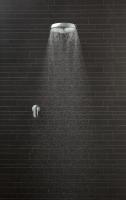Martin Walker, CEO of Methven UK, looks at the future of the bathroom industry and how new technologies and materials can offer benefits to installers and end users.
The article will look at how the industry has adapted to challenges over the last year and will look ahead to the challenges of the next 12 months, asking what technologies and materials will shape the bathroom industry in the future.
The challenges surrounding water usage are well documented, with demand set to grow by 55% in the next 30 years. Furthermore, with the global population set to rise by almost three billion people to ten billion by 2050, the necessity to ensure we are able to cope with the increased strain on the planet’s  resources has never been more important.
resources has never been more important.
One area in which we can make advancements is in innovations which have been informed by biological mechanisms, including the materiality of plants and animals. Biomimetic materials, those that mimic the properties of natural substances, are becoming increasingly used in everyday life.
A great example of biomimicry in the bathroom arena is the lotus leaf. For years scientists have studied the plant’s hydrophobic (water-repellent) properties which allow it to self-cleanse. The micro and nanoscopic architecture of the leaf means that water droplets are not absorbed and instead collect on the surface and gather dirt before running it off the edge. These properties have now been mirrored in manmade materials and have begun to be used in product development.
We have already found a way to incorporate this type of technology into a product to help our showers use water more efficiently - Methven’s patented Aurajet® technology uses similar technology to the lotus leaf. The impinging surface, which jets fire water onto to create a fan-like spray, is made from Polypropylene, chosen specifically for its low surface energy, meaning it acts in a hydrophobic manner - repelling water and preserving spray-quality. This allows both water and energy to be saved without negatively affecting the overall shower experience. Importantly, it also resists limescale build-up, reducing the time needed to clean and therefore offering further benefits to consumers.
 Similarly, the Aio brassware range is manufactured from Eco Brass®, a new high-strength brass alloy which is lead and heavy metal free, offering enhanced corrosion resistance and therefore preserving water quality. The material has a lead content below 0.1% and meets with all hygiene requirements worldwide. Legislative pressure to reduce or remove the lead content from brasses, particularly in water fittings and especially from drinking water fittings and systems, has produced an increased demand for these low-lead, or lead-free, products. With water such a vital resource, improving its quality and protecting against contamination is key.
Similarly, the Aio brassware range is manufactured from Eco Brass®, a new high-strength brass alloy which is lead and heavy metal free, offering enhanced corrosion resistance and therefore preserving water quality. The material has a lead content below 0.1% and meets with all hygiene requirements worldwide. Legislative pressure to reduce or remove the lead content from brasses, particularly in water fittings and especially from drinking water fittings and systems, has produced an increased demand for these low-lead, or lead-free, products. With water such a vital resource, improving its quality and protecting against contamination is key.
With the pressures and concerns related to water consumption only set to increase in the coming years, and the bathroom accounting for two thirds of household water usage, it is now vital that the bathroom manufacturing industry places itself at the front of the technological curve. By adopting new technologies, bathroom manufacturers must look to address one of the most pressing concerns facing the planet and begin to develop new methods of using less water more efficiently.



Add new comment